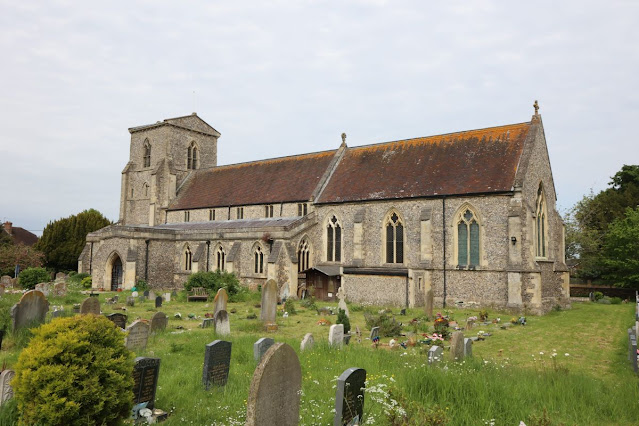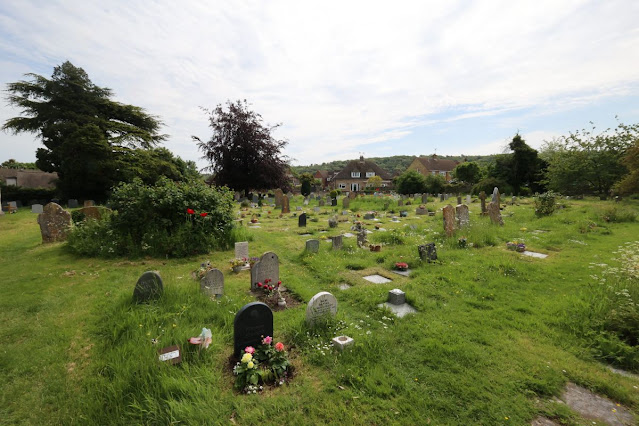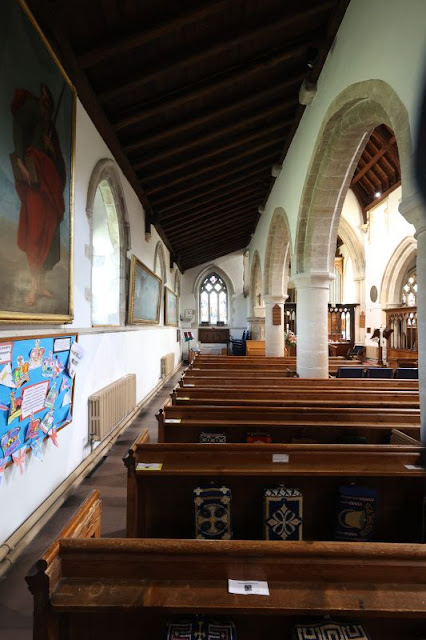St Andrews Chinnor was the next church I visited which was only a few miles along the road from Crowell church. The church has been on my radar for a while and I was glad to be able to visit
"The earliest record of the Church of England parish church of Saint Andrew is from 1160. The nave was rebuilt in the 13th century, when the present arcades of four and a half bays for first the north aisles and then the south aisle were built. Building of the present tower began towards the end of the 13th century. Early in the 14th century St Andrew's was remodelled. The chancel was entirely rebuilt, the tower was made higher and the porch was built. The aisles were widened, given new windows, and extended westwards to flank either side of the tower. A rood screen was installed between the chancel and nave. The chancel and high altar were dedicated in 1326, which may therefore have been the year that the remodelling was completed. The high-pitched 13th century nave roof was replaced, probably later in the 14th century, with a Perpendicular Gothic clerestory and low-pitched roof.
The architect Richard Pace designed St Andrew's Rectory, which was built in 1813. St Andrew's was restored in 1863–66. The plans were by the architect Edward Banks of Wolverhampton but were modified by the Oxford Diocesan architect G.E. Street and the Oxford architectural writer and publisher J.H. Parker. The nave roof was restored to a high pitch and the chancel was raised above the nave. Clayton and Bell restored the medieval stained glass and added a new east window. The 14th century font was replaced with a new one of Caen stone. The 14th century rood screen was reduced in height. The chancel, nave and aisles were entirely refurnished. However, in 1930 the original font was retrieved and reinstalled.
In the south aisle is a carved recumbent effigy of a knight of about 1270 or 1300. St Andrew's has also one of the largest collections of monumental brasses in the country. Most are 14th or 15th century but there are also later brasses commemorating a churchwarden (died 1899) and his wife, and two soldiers killed in the First World War.
By 1558 St Andrew's had a ring of four bells and a Sanctus bell. In the succeeding century all were replaced and the ring was increased to five. William Knight II of Reading cast the oldest bell in about 1586. Further bells were cast by Henry Knight I in 1620, Ellis Knight I in 1635, and Henry Knight II in 1663. A tenor bell was cast in 1651, but in 1864 it was recast as two smaller bells increasing the ring to six. In 1965 John Taylor & Co of Loughborough cast a new Sanctus bell and in 1969 the same company cast a new treble and second bell to replace the two 1864 bells. St Andrew's parish is now part of the Benefice of Chinnor, Sydenham, Aston Rowant and Crowell."
The belltower unusual in it's shape
South side view of the church taken with my phone
East end of St Andrews
North east view of the church
Another view most likely taken from the roadside
South east view showing the shape of the belltower
The churchyard as you walk along the path
Around the south side
Looking south
South again looking along the east end of the church
The churchyard along the north side where it is thought around 50 roundheads killed in a nearby battle are buried
Looking towards the west boundary wall
Churchyard along the west end of the church
Your first view inside the church from the doorway
Wide view looking down the nave from the back
The chancel arch with rood screen and cross
Closer view of the arch, 14th century rood screen and cross
The chancel
Wider view showing the organ pipes either side of the chancel
Looking back towards the rood screen
Low window in the chancel
The east window
The altar and est window from in front of the altar rails
View back to the rood screen showing the choir stalls either side
Some of the 14th century church brasses which were lifted form tombs in the church and now shown on wall plaques in the chancel
View back though the 14th century rood screen to the nave, the box over on the left of the photo is most likely the organ
The Pulpit with small organ in front
Closer view of the carvings on the pulpit
View from the pulpit showing the nave, south and north aisles
The church has quite a few stained glass windows these I am assuming are the 14th century ones
These show bible scenes
There are also memorial windows which made me look at them closer
The north aisle
The east end has an altar and the rolls of honour for the town
The east wall holds the fallen from WWI
Above you can see the stained glass window
The north wall you will find the fallen from WWII
At the back you will see an 14th century font dating back to the original church, it was uncovered when they were doing some building work
The south aisle
At the end you find the altar along with tomb effigy
I like the altar cover
Above the stained glass window
Effigy of a knight from the Danvers family 1270
The font at the back of the church
The west window
You cannot miss this George II coat of arms when you walk in the Church
But you can miss this one which I think is Charles I
Look in the north aisle and you might notice this doorway up high
In the nave is the exit which would have taken you on to a rood loft
Paintings along the south aisle wall

.jpg)


















.jpg)
.jpg)


.jpg)
.jpg)

.jpg)




.jpg)
.jpg)
.jpg)
.jpg)


.jpg)

.jpg)








.jpg)
.jpg)


.jpg)
.jpg)
.jpg)


12 comments:
It's a really nice church, the stained glass windows and the candelabras blow me away
Beautiful, especially the stained glass.
Beautiful old church. Thanks for sharing
Greetings from St James Trinidad
Happy Monday
mine is HERE
Much♥️love
What an impressive church. Some money has gone to support that down the years. I thought that the carvings on the pulpit were most unusual, and that lovely stained glass window featuring Colin Cuthbert, bless him.
A super church - the Rose Window is just stunning and I like the brasses and the carvings on the pulpit. Good to see they have kept the old font too. The church looks really well looked after.
A truly astounding potpourri of beautiful churches to be found on your blog. As a Yankee, I am envious of the history you have at hand, seemingly around every corner.
Thank you for sharing at https://image-in-ing.blogspot.com/2023/06/briam-mmmm-good.html
Lovely church inside and out. The churchyard looks very well-kept.
That structure makes me think I'd love to have a house that looked like that from the outside. Reminds me of the older but smaller castles.
Beautiful church building, and the windows and altar cover are especially lovely.
The building is outside unpretentious... but in the church is such an artistic wealth! I enjoyed so much.
Thank you for sharing at
MosaicMonday
It's a very long church! The paintings around the altar are unusual, as is the George II coat of arms - it looks a bit like the sign for a pub.
I do love the windows, they are stunning - thanks for sharing and for linking up with #MySundaySnapshot.
Post a Comment